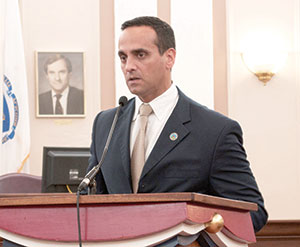
Mayor Curtatone explained the city’s plan for creating more affordable housing with its “Sustainable Neighborhoods” program at a public meeting last week. — Photo by Douglas Yu
By Douglas Yu
The SomerVision plan is undergoing improvements in response to the gradual gentrification of neighborhoods, lack of affordable housing and forced out long-term Somerville residents.
The City of Somerville held a public meeting at City Hall on Wednesday as Mayor Joseph Curtatone launched a comprehensive affordable housing program called “Sustainable Neighborhoods.”
Curtatone explained that a sustainable neighborhood is more than just buildings with great design and infrastructure, it also means, “maintaining a certain population of people who want to be part of the community and contribute to the community.”
According the presentation, the Greater Boston area is one of the most expensive housing markets in the U.S., and during 2000 to 2007 Boston was the most gentrifying large city in the nation. In certain parts of Somerville, people are more concerned about their rent since the Green Line Extension (GLX) is making its way through the city, rendering those residential areas more expensive to live in the near future.
“Even without GLX, the city still faces regional housing issues and pressure,” Curtatone pointed out.
When SomerVison was finalized by the city in 2012 with a stated mission of making Somerville a more exceptional place to live, work, play and raise a family, one of the goals was to create an additional 6,000 housing units and 1,200 permanently affordable ones by the year of 2030.
Earlier this year, Metropolitan Area Planning Council (MAPC) partnered with the Somerville Community Corporation (SCC) and the City of Somerville to research and report on the impact that the GLX would have on the housing market in the city.
Now, based on MAPC’s report that the city needs 6,300 to 9,000 new units, Somerville seeks to revise goal to maximum recommendation of 9,000.
The shifting demographic is one of the causes of a stressful Somerville housing market, according to Curtatone.
“Forty-five percent of the world’s population live in the city,” Curtatone said. “And we know through a recent MAPC report that the 101 cities and towns in the Greater Boston area has a need for 435,000 homes from market, rental, workforce, and lease by 2040.”
According to the Metro Boston Community Types chart that was shown during the presentation, the highest demanded housing type, especially in the inner core of a city, is multifamily.
In the next couple of decades, most people in this world would be living in urban areas, said Curtatone. Therefore, dealing with such a high demand to live in the cities, such as Somerville, should be of strategic concern.
Currently, approximately 3,450 affordable units in Somerville were created through the Affordable Housing Trust Fund, Inclusionary Zoning and Federal and State funding, subsidies and tax credits, according to the city. 26 percent of new housing units created in the past six years are affordable units.
Efforts have been made in the past to preserve a certain amount of affordable housing in Somerville. One of the most forward-thinking ones is the passage of Community Preservation Act (CPA).
“CPA’s committee has dedicated the majority of their funding towards affordable housing,” Curtatone said. “But it is not enough. We need to take some bold steps.”
The chart also shows that over 40 percent of Somerville households are cost burdened, which means these residents spend 30 percent or more of their gross income on housing.
“That’s before they start thinking about putting their kids in a soccer program, having fun and buying clothing,” Curtatone said. “It’s not just the people who are stressed, it’s the region.”
The city is going to tackle these pressing housing issues with six major actions to be proposed to the Board of Aldermen immediately. Those include 100 Affordable Homes Strategy, Comprehensive Zoning Reform, Tax Credits for Benevolent Landlords, Local Transfer Tax, Setting New SomerVision Goal and Innovative Affordable Housing Design Competition.
Ward 7 Alderman, Katjana Ballantyne is concerned about the financial plan for implementing the new program. “The ‘Sustainable Neighborhoods’ program hasn’t been outlined in terms of details. If you develop affordable housing in new parts of Somerville, you haven’t necessarily generated more revenue for the city,” Ballantyne said.
Ballantyne questions if the taxes in certain parts of Somerville would go up in order to maintain the affordable real estate housing, and she also expressed her concern that there were not enough business spaces to offset the residential tax cost of affordable housing.
Curtatone agreed that taxing businesses to relieve residents of paying taxes for affordable housing was totally legitimate. He said that the city is building business office spaces in Union Square and Assembly Square, but it will take time to move forward in that direction. To attract builders and investors to commercial properties, the city also has to demonstrate that it has created a talent pool that would utilize those spaces.
A couple of Somerville residents who attended the meeting applauded the new program and hope to see it take place.
Curtatone said the new program is not intended to prevent new immigrants from moving into Somerville, and “in fact, we want them to move here and we want their kids to be able to stay here. They make up the very unique characteristic of this community, which is diversity, and that’s who we are.”
See the full presentation slideshow here: http://www.somervillema.gov/sites/default/files/documents/sustainable-neighborhoods-presentation-10-15-2014.pdf.

 https://www.portersquarebooks.com/
https://www.portersquarebooks.com/













Reader Comments